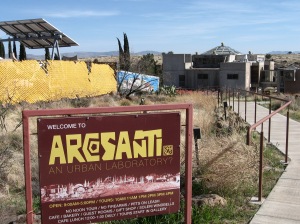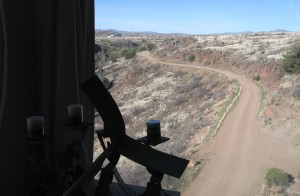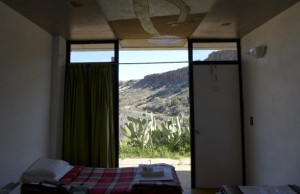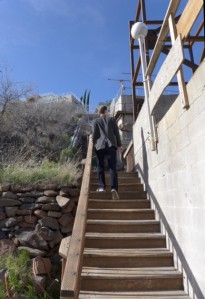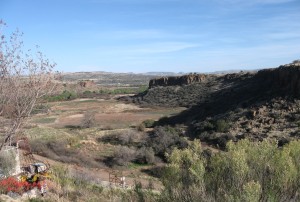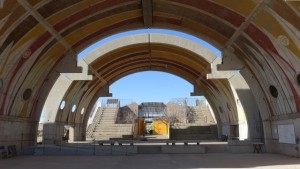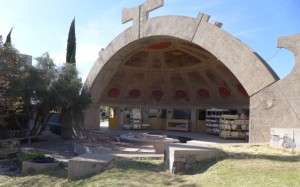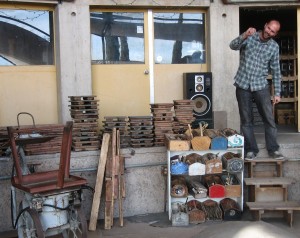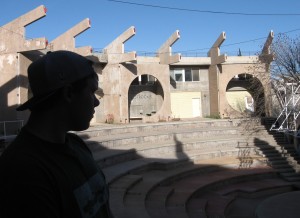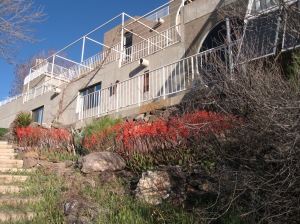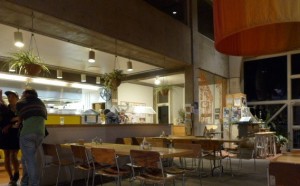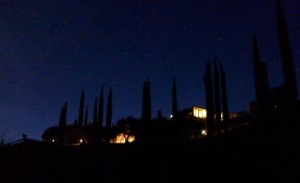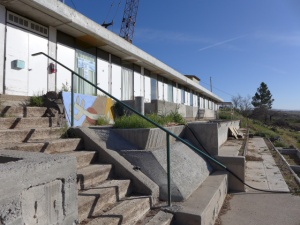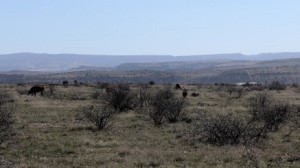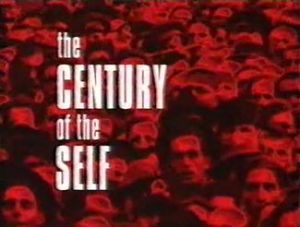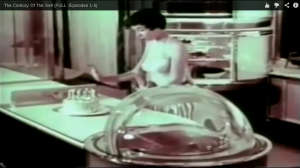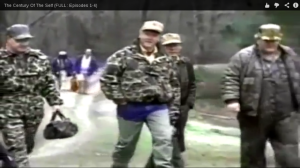In Meat We Trust:
An Unexpected History of Carnivore America
by Maureen Ogle
Houghton Mifflin Harcourt, 2013, 384 pp.
The Meat Racket:
The Secret Takeover of America’s Food Business
by Christopher Leonard
Simon & Schuster, 2014, 370 pp.
We’re all adults, here: We know where meat comes from. Seriously, we all do. There’s no shortage of books to shade in the details, with Fast Food Nation over a decade old and The Omnivore’s Dilemma ubiquitous enough, by now, that it would require real effort to stay ignorant of its main thrust. The genre’s vegetarian branch has ripened into a certain decadence, with consumer choices for every aesthetic stripe (Animal Liberation for the brainy clinician, Eating Animals for the hip postmodernist, Elizabeth Costello for that rare reader of literary fiction), and although I’m not one of them, pro-meat readers, too, can fill up on titles like The Shameless Carnivore and Meat: A Love Story. All these books take different stances toward industrial farming, but they agree that it’s an issue people can affect via their individual dietary choices. So it’s something of a surprise to find two new books, both popular histories, with a decidedly less cheerful slant. Both argue for the system’s incontrovertibility, even as they’re both written to decry this deadlock’s late state.
There might be something perverse in my claim that both titles under review argue that things can’t be changed, since Maureen Ogle, in her introduction to In Meat We Trust: An Unexpected History of Carnivore America, says exactly the opposite. “My hope is that that this book will help all of us understand how we got to where we are so that, if we are willing, we can imagine a different future and write a new history of meat in America.” But if this is a hope, it’s decidedly not the main focus of the text. Instead, as she bluntly writes in an early endnote, “Readers should note that my general argument in this book is a rejection, overt or otherwise, of the Marxists’ critique of ‘capital.’ I am aware of that argument … I don’t agree with it and find it singularly useless for making substantive change.”
Ogle’s project is to dampen the “sense of entitlement” that has grown from the misconception that some “Elysian idyll” ended “when corporations barged in and converted rural America into an industrial handmaiden of agribusiness.” But if she merely aims to correct misinformation, it’s often difficult to distinguish her strenuous articulation of the logic of business from an approval of this way of thinking. You can only portray so many agriculturalists as heroes and reformers as schmucks (Upton Sinclair is characterized as an “impetuous, publicity-starved writer” and a “fair-weather socialist”; Ralph Nader gets off merely as “eccentric” and “[d]riven by zealousness that bordered on fanaticism”) before your sympathies become impossible to ignore.
Here’s a quote to give some idea of Ogle’s style, with its contradictory urges to reveal that things once were even worse and to document that the present is not so unlike the past, after all. It comes midway through the second chapter, “We Are Here to Make Money,” which concerns the switch from live shipments to dead ones, “dressed,” since chilled carcasses are easier to move uninjured than warm animals. Specifically, the sentence is from a section detailing the “visual and aural feast” that attended urban butcheries, with their consequent flows of blood and urine in the streets. Ogle writes, “Throngs of children hung about to watch with fascinated delight, hanging on every word of the ‘not very elegant language’ of the butchers’ world, becoming, critics complained, ‘habituated to scenes of blood and violence,’ a gory and three-dimensional nineteenth-century version of the computer games that adults fret about today.”
This leads into a pagelong description of the viscera heaps that would be found in every 19th-century city, a description that, with any other framing, would read as an indictment of the savagery of butchery itself. It functions instead, though, as a lead-in to justify why it was reasonable for city dwellers to force these butchers to operate in centralized slaughterhouses, one among the book’s many examples of the “conflict between public good and private interest.”
In Meat We Trust is valuable as a compressed narrative of the last two centuries of the animals in agriculture, but the danger of this compression is to make its events seem inevitable. The early rise of the Beef Trust, with its colluding megapackers, is shown to be a result of the thin margins resulting from Western overgrazing and cattle overproduction in the late 1900s. Factory farming of chickens, then pigs, is said to have been inspired by nothing more than “a desire to keep food costs for consumers low and a need to ensure that farmers enjoyed an adequate standard of living.” Boxed beef, antibiotics, tenant farming, union busting: though each has its individual nuances, the overall story is always the same, one of a difficult business world wherein farmers must respond to a carnivorous public that demands enormous quantities of flesh, at a high quality and a low price.
Ogle gives the last two chapters of her book (“The Doubters’ Crusade” and “Utopian Visions, Red Tape Reality”) to the rise of alternative ag and its inevitable discontents. She’s generally skeptical of such trends—the old saw about how grass-fed beef couldn’t feed the entire country is approvingly quoted—but nevertheless sighs that “alternative is the new normal,” a phrase which she deploys ironically to critique alternative agriculture as just another in the long line of specious ways to sate our simultaneous American longings “for convenience, for cachet, for doing good.”
Christopher Leonard’s The Meat Racket: The Secret Takeover of America’s Food Business also hinges on a vision of the new normal, but “niche localvore farmers” aren’t mentioned until the very last page of the book, and then it’s only to note that most “middle- to low-income Americans” won’t buy their stuff. Nothing in The Meat Racket, aside from an ambiguous note in the acknowledgments that Don Tyson is a “genius,” is overly hot on industrial meat, but after 300+ pages of demonstrating the relentless gains of Tyson et al., Leonard concludes, “It’s unclear if anything will change this pattern.”
Where Ogle is wry, Leonard is glum. The biggest difference between these books is that while Ogle, by profiling the major important historical trends, covers mainly winners, while Leonard goes in tit for tat, winners with their losers alongside.
By focusing on one company, Tyson Foods, and its interactions with one town, Waldron, Arkansas, Leonard gives us an industrial cross section based on interviews with participants ranging from Don Tyson to the farmers his business model has bankrupted. The Meat Racket is a triumph of specificity, giving names and dates in place of half-formed generalities.
This makes the book hard to dismiss, even if one starts out skeptical. The first chapter, “How Jerry Yandell Lost the Farm,” is the narrative of a Waldron farmer whose successive losses are deployed to show how Tyson has outsourced most of its risk to the farmers who do its work. The company hatches the chicks, produces their feed, delivers them to farmers, picks them up, slaughters them, and sells their meat to the grocers and restaurant chains. And while this vertical integration, on one hand, allows Tyson to cut down on many of the equipment doublings that could lead to higher prices, it also gives them a tyrannical power. Farmers have to use whatever chicks they are given, whatever feed they are given, and their pay depends on how well they do with these raw materials. In fact, there’s another draconian caveat: the farmers’ efficiency is fastidiously ranked, and those farmers whose output is least efficient are docked in the price they are paid per pound, a further penalty for failure.
Given that the farmers have to pay for their own equipment and may have to work with less-than-perfect chicks (the Jerry Yandell arc levies the possibility that he was delivered weak animals that, in the past, would have been culled), it’s not surprising that few farmers make it in the long term. One might ask why potential farmers wouldn’t simply work with different companies, but Leonard takes pains to answer this question. With so much of the market structured via similar contracts, the free market for meat, in many industrial sectors, has all but disappeared.
The first part of The Meat Racket documents how this happened. John Tyson’s original competitive advantage was simply to exploit price differences—buy rural, sell urban. His son, Don Tyson, was the one to introduce the tenant farming paradigm. Though Don “experimented with the model of owning farms outright,” he soon ran into the central difficulty of this aspect of vertical integration:
It was hard to motivate hired hands to do the work, which involved hauling loads of dead chickens out of a barn where the ammonia fumes were so strong they burned the eyes. Hired hands didn’t raise the best birds, no matter how much you paid them or what kind of incentives you provided. They didn’t have skin in the game.
Don crossed the country signing letters of intent so his contract farmers could get loans from the Farm Credit Administration, thereby offloading a significant portion of his venture’s loss to the US Government. The next half-century for Tyson Foods is a story of rise and rise, from changes in the animals (1955: 73 days to raise a 3.1 pound bird; 1982: 52 days for a 4 pounder) to trends in consumption (see: Don Tyson’s courting of Wal-Mart, McDonald’s).
But if the story of Tyson starts as one that’s specifically about poultry, The Meat Racket‘s second section, “The Great Chickenization,” tells how the Tyson model of concentrated agriculture—along with tenant farming—eventually overtook cow and pig production, too. There were plenty of technical challenges to raising pigs in this way (“the biological equivalent of putting hundreds of large people in a barn with no toilets or running water”), but the business benefits of controlling the productive means, or, rather, the benefits of controlling the most profitable sectors of those means, was enticing enough to lure Don into the experiment. And once Tyson had cracked the basic method, competitors like Smithfield Foods adopted and extended it with a vengeance.
This sort of control wasn’t quite possible for cattle, whose unique stomachs require them to feed on milk and grass for nearly a year before they can enter the feedlot. But when Johnny Tyson, Don’s son and short-lived CEO of the company, bought IBP, the same boxed-beef purveyors who got a whole chapter of In Meat We Trust, the beef industry began to look the same as all the rest. After telling us how 85% of all cows are bought by just four companies (Tyson, Cargill, JBS Swift, National Beef), Leonard makes a heavy allegation: “There is ample evidence that the big four meatpackers have chosen to divvy up the market, picking territories where they can buy all the cattle from the feedlot without facing a competing bid.”
As for the evidence he gives of this, I could imagine Ogle shaking her head. “No one,” Leonard admits, “seems to think the meatpackers are dumb enough to have an actual sit-down meeting to divvy up territories where they won’t compete against each other. But then again, they don’t have to.” The numbers Leonard has on this—individual feedlots consistently selling to just one of the four big guys—are on the level of the century old Beef Trust accusations, which Ogle’s narrative included to show the naïveté of American consumers, always looking to blame someone besides themselves.
The last section of The Meat Racket concerns the Obama administration’s unsuccessful efforts to break these de facto monopolies, but the ending is more downbeat than necessary. We’re walked through beginning intentions vs. ending disappointments, from the original reform draft with its provisions to forbid contracts with added penalties, to allow farmers to press lawsuits for individual harm, to ban packers from owning livestock—all reforms aimed to shift power toward small producers—and on to the final, gutted version, which, in any case, was defunded by the House of Representatives. The book’s closing pages are given over to statistics of continued growth. “Tyson’s results reflected that even in hard times, people need to eat. And when people eat, Tyson’s products were all but unavoidable.”
We’re all adults here: We know that reforms don’t come easy. “The only way to avoid [Tyson],” Leonard concludes, “was to become a vegetarian.” This comment seems intended as a hopeless shrug, but to at least one reader, it sounds like a solution, a way to cut that old Gordian Knot. Of course, I’ve had this conversation enough times to know that most readers won’t agree. In both The Meat Racket and In Meat We Trust, the main sufferers are those people who wade through shit and slice through guts, not those animals whose shit they’re wading through whose guts they’re about to slice. But, again, we’re all aware of the equation’s other side, and we’re all aware that this means that many staples of the American diet, from corn dogs to chicken wings, have costs not on the balance sheet. These foods’ facade of comfort and normalcy—and, fine, sure, their basic overall taste—conspire to keep most of us as satisfied consumers. The contribution of these two books is to illuminate the human costs of this consumption, alongside he costs we already know about but choose to accept.

